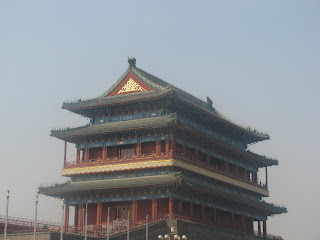I started my trip to India in Chennai, where my first stop was an Indian department store. In India women are expected to dress much more conservatively than in America. Many women still wear traditional saris or shalwar kamiz. I wanted to be respectful of their culture so I bought a few Indian clothes, which were also perfect for the hot weather. In Tamil Nadu, the state that Chennai is in, there is an incredible amount of poverty so the government has come up with a plan to stop child labor and encourage more kids to go to school. All students who attend school were given two full meals, which helped kids who were not getting enough to eat at home, and the parents of the child were guaranteed a certain number of paid work days a year. Each family was also provided with an allotment of rice per student that attended school. Next I headed to Agra, the home of the Taj Mahal. We visited Fatepur Sikri, an imperial city that had been abandoned only sixteen years after construction. We also walked around a fort in Agra that was built by ancient Indian rulers and remained in use through British colonialization. The British colonialism in India left a profound mark on the country through architecture (in fact the capital buildings in Delhi are old British colonial buildings), a love of cricket, an abundance of tea, the organization of the Indian school system, and ethnic and religious divisions. While India was a British colony the British played up religious differences and ignited previously non-existent conflicts between Hindus and Muslims so that they could not unite to overpower British colonial forces. This ultimately led to the separation of India from Pakistan and Bangladesh. These kinds of problems are still relevant in India today as religious and ethnic differences still cause friction between groups of Indians. We also visited the famous Taj Mahal, which was completely breathtaking. The Taj Mahal was built by an Indian Emporer, Sha Jahan, in the 16th century for his wife who died in childbirth. We next went to the holy city of Varanassi. Varanassi is on the banks of the Ganges river and is considered the holiest city in India. Thousands of pilgrims travel to the river to wash themselves clean in the water. We went to a religious ceremony one evening performed by Hindu priests on the banks of the river and also visited the river at sunrise when pilgrims come to bathe in the water and young monks and priests come out to do their morning yoga and prayers. Health care in India has similar aspects to American health care. You must hold insurance that you pay for or get through work in order to be treated. The hospitals are not very clean. In one hospital there was trash on the floor, lots of people sleeping among the trash. The technology was lower quality and levels of hygiene were considerably lower. We also went to Mamallapuram, the site of many ancient temples. The temples are carved out of rock with elaborate engravings and decorations. The stonework was incredible and I was overwhelmed by the sheer number of temples.




















































